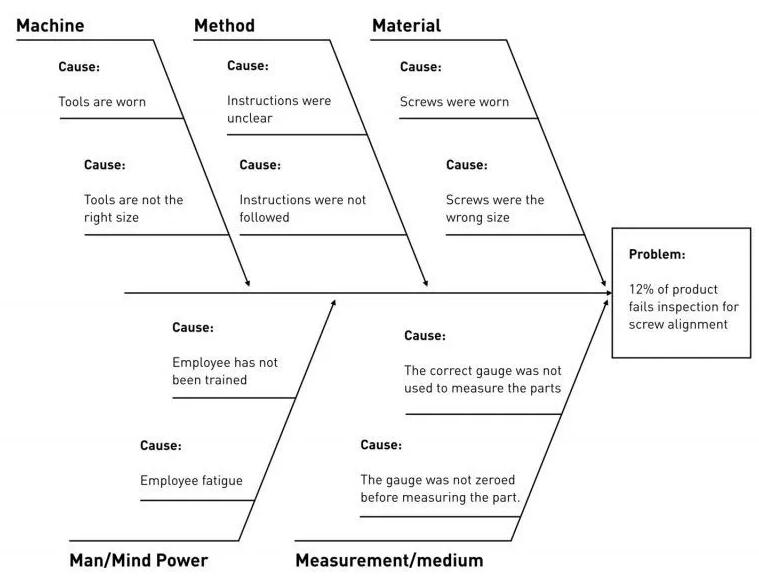Quality control methodology has undergone a long period of change, involving a broadening of the subject to enhance many more aspects of the production process and product than were traditionally considered. These changes have had major effects in the field of internal management organization, as well as in the commercial relationships involved in the procurement of castings.
Casting defects can negatively impact the profit margin of the company. There are instances such as rework costs or casting scrap costs that not only affect financial state of the company but also affect customer services. However, in many cases, the casting defects may appear at the machining stage, at the assembly stage or during use of the component. The resultant value added costs and warranty costs may sometimes be passed on to the foundry by their customers.
Let’s take a look at the kind of defects and how they can be identified.

Cracks and other flaws communicating directly with the surface of the casting can be detected using techniques including penetrant methods, chemical etching and oil and chalk testing. The penetrant methods are based on the use of fluids to permeate and highlight defects by increasing their contrast and are helpful in establishing the soundness and integrity of thin walled castings in cases where pressure testing is difficult to execute. If there is any seepage, then it can be easily observed.
Very fine surface cracks and similar defects may be masked by a thin layer of metal resulting from superficial plastic deformation. This can occur in shot blasting, in fettling or even in the machining of a casting. The masking layer may consist of oxide scale formed in heat treatment.
The surface of the casting is treated with a dye solution based on a low viscosity solvent which is applied by brush or aerosol spray or the casting can be entirely immersed in a tank of solution; the casting is then thoroughly rinsed and dried. After a time, seepage of residual fluid occurs from cracks and other narrow surface defects to produce a visible stain.
This long established technique uses paraffin oil as the medium. The casting is treated, usually by immersion, with heated paraffin; it is then rinsed in detergent solution and water and dried. Using a low pressure air dispenser the surface is coated with dry powdered chalk, which becomes marked after a time by seepage of paraffin from cracks or porous zones.
For the characteristic criterion of quality level measuring, it is assumed quantity of defects in one year. The first step of analysis is the assessment of process by means of diagram.
Diagram of cause and effect, or “fish bone” diagram – makes possible identification of sources of problems formation, helps quality a sequence of causes and makes easy problem solution.

problem of non-conformances formations in process of casting products
The general origins of defects lie in three sectors:
1. the casting design,
2. the technique of manufacture–the method,
3. the application of the technique–‘workmanship’.
Standardization and optimisation of all aspects of the production technique offers the best way-out against such troubles. More specific precautions can be taken in those cases where there is a known susceptibility to a particular defect, whilst the radical approach of design modification may need to be considered in the extreme cases which do not respond to changes in foundry technique. It should be clear that any approach to the elimination of casting defects must be on an economic basis.
1. Shaping faults arising in pouring.
2. Inclusions and sand defects.
3. Gas defects.
4. Shrinkage defects due to volume contraction in the liquid state and during solidification.
5. Contraction defects occurring mainly or wholly after solidification.
6. Dimensional errors.
7. Compositional errors and segregation.
Casting defects, whatever their cause, cannot be considered in isolation; their significance can only be established in relation to the function of the casting. Behaviour under service stresses and environment is in most cases the important reason behind the appearance.
The first one is the quality and the parameters of moulding and core mixtures. Number of the defects was affected by temperature and humidity of ambient air, both in store yards and in moulding mixture preparation shop. Consequently, it is reflected in moisture content of silica sand and moulding mixture. This fact can affect the quality of moulding and core mixtures and their prone to disintegration by molten metal flow.
The second one is the presence of complicated design of the cavity in the mould, containing thin walls, profiles, runners. From this fact follows the necessity to design parameters of moulding mixtures from the mould complexity point of view.
Copyright:@2020-2021
Comments Please sign in or sign up to post.
0
0 of 500 characters used